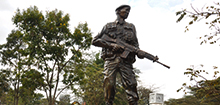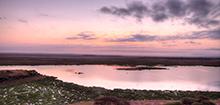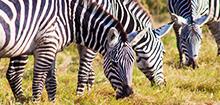
Date Published:
Pomp and stateliness underlined the Kenya Wildlife Service’s commemoration of the Nairobi National Park’s 75th birthday on 16 December, 2021, with the occasion being led by Kenya’s fourth president, His Excellency, President Uhuru Muigai Kenyatta, at the Kisembe Site in the park.
Addressing the masked gathering, President Kenyatta expressed joy at being present at one of the world’s most iconic protected areas, which has the singular distinction of being the only national park in the entire world adjacent to a bustling metropolis, where residents and international visitors can engage with nature.
H.E. Kenyatta explained that the celebrations were a reaffirmation of the Government’s commitment to preserving Kenya’s natural beauty and passing the same to future generations in pristine condition. “Those that came before us made deliberate choices to balance rapid social and economic development with the conservation of our plant and animal life. Because of this foresight, Kenya today prides itself as having a thriving national park system, comprising 23 terrestrial and four marine national parks; 28 terrestrial and six marine national reserves as well as seven national nature sanctuaries,” the president said, noting also the thousands of local parks, arboretums, large gardens and green spaces thriving at county level. He reiterated that Kenya is proof that development need not be at the cost of nature and the environment, mentioning the yin and yang that is towering skyscrapers alongside towering giraffe’s necks; the sound of traffic minutes away from the calls of various wildlife; and the digital savannah at Konza City a stone’s throw away.
President Kenyatta stated that all concerned agencies and individual citizens must always remain alert to play their rightful role in protecting our inheritance in order to conserve and improve upon our natural beauty. “This calls for proactive management plans that address current threats and anticipate future ones. To this end, the Ministry of Tourism and Wildlife should implement the Management Plan for Nairobi National Park, to ensure that the park serves humanity for posterity,” His Excellency said.
The Commander-in-Chief reiterated that threats still abound; poaching, habitat fragmentation and degradation, changes in land use, human encroachment and the adverse impact of climate change. These are compounded by the increasing levels of Human Wildlife Conflict, inadequate financing from conservation activities, lack of personnel, resources and equipment. He averred that his Government was trying to alleviate some of these challenges by increasing the National Budgetary Allocation to environment and wildlife conservation, and would continue to increase support for the conservation agenda.
His Excellency noted that poaching and illegal wildlife trade is a multi-faceted issue, encompassing development, economic, environmental, and social and security dimensions. “As a Government, we are committed to eradicate poaching, and to end the illicit trade in wildlife. It is critically important to raise awareness, not just on the serious effects of wildlife crime, but also highlight the need to secure wildlife habitats. We have had an opportunity to increase this park by an additional 2,000 acres, and further expanded the corridor to the Swara International Livestock Research Institute (ILRI) by increasing the space by a further 1,900 acres,” the President added.
President Kenyatta commended the Ministry of Tourism and Wildlife and the Kenya Wildlife Service management, for the job they are doing in ensuring the conservation and protection of Kenya’s national parks and wildlife. He thanked the Cabinet Secretary in the MoTW and his team for the passionate leadership and commitment espoused while protecting the unique national treasure that is Nairobi National Park. His Excellency noted with pride that the number of cases of poaching, especially for endangered animals is almost zero, stating that one rhino was poached in 2021, but the culprits were apprehended and the trophy recovered. “We remain committed to continuing to support KWS and its multiagency partners in their quest for completely eradicating poaching from our midst. It is very pleasing, for the last few years, to consistently get reports of increasing numbers, especially of the most endangered species,” he complimented.
The President urged MoTW and KWS to embrace new technological innovations to address wildlife challenges, particularly poaching. This will greatly improve efficiency and reduce costs, as well as provide avenues for local universities to contribute to this noble campaign. H.E. Kenyatta paid glowing tribute to the pioneers of conservation in Kenya, whose dreams of preserving our national treasures led to the present reality enjoyed by multitudes. “To honour these heroes, the Ministry of Tourism and Wildlife is today directed to put in place a recognition mechanism for such heroes, with a special category that also recognizes the efforts of our young, future conservationists,” he said. The President looked forward to honouring Kenya’s youth who contributed to keeping parks clear of litter, as well as those in rural areas who have also taken steps to address Human Wildlife Conflict in their communities and others who have used their talents and platforms to bring awareness to the need to conserve our natural beauty and wildlife. “By highlighting this next generation of conservation heroes, we are not only providing them, and others, with an example that other young people can follow, but we also lay the foundation for a new generation of nature warriors who will take up the fight in years to come,” he added.
President Kenyatta underscored the fact that for 75 years, the Nairobi National Park has been the shine of the ‘green city in the sun,’ and he hoped that the park would remain in the same pristine condition for the next 75 years and well beyond. He thanked MoTW, KWS, the Bohra community, KWS rangers and all other development partners, even as he wondered about the future of conservation in the face of burgeoning populations: with an estimated 100 million people in 2063, the president stressed the need to think outside the box in terms of preservation of our wildlife heritage.
Cabinet Secretary in the Ministry of Tourism and Wildlife, Hon. Najib Balala, said that in previous days, Kenya’s former Presidents – Mzee Jomo Kenyatta, Daniel Moi, Mwai Kibaki and even Uhuru Kenyatta – specifically visited Nairobi National Park to burn and destroy tonnes of ivory tusks and rhino horns. As such, the current president’s attendance during the commemoration of Nairobi National Park’s 75th anniversary was special because it highlighted KWS’ efforts in conservation.
Hon. Balala thanked the President for expanding space for wildlife by expanding Nairobi National Park’s boundaries by 2,000 acres to open up the southern Athi-Kapiti area, saying that all conservationists highly appreciated this gesture. The CS lauded KWS’ anti-poaching efforts, which saw zero rhinos and 11 elephants poached in 2020. He stated that one rhino was poached in 2021 at Ruma National Park, but the poachers were immediately arrested and the trophy recovered. “We have established 170 community conservancies across the country, because we value the wildlife that is beyond protected areas and recognize that communities play a major role by being the buffer zone around protected areas,” Balala said, reiterating that his ministry had created a conducive environment for partnerships with donors and NGOs. He highlighted the success story of protecting endangered species, which had resulted in increased populations of rhinos and elephants, at 1,700 and 36,000 respectively.
Hon. Balala stated that the biggest conservation challenge was climate change and lauded the President for ably representing Kenya during COP26, where he committed to harnessing low-carbon investment opportunities. The CS committed to Net Zero (the state that exists when the amount of energy provided by on-site renewable energy is equal or equivalent to the amount of energy used) for energy in Nairobi National Park, stating that all of KWS vehicles and facilities domiciled in the parks would be ‘green.’
The CS said that while Human Wildlife Conflict was a perennial problem facing conservation, there is a need to coexist with our wildlife heritage and to become innovative in getting compensation for the victims. Hon. Balala said that competition for land, such as agriculture, is a thorny issue in conservation, as well. He said that wildlife corridors must be preserved, even as he encouraged sustainable agricultural practices, adding that economic and financial sustainability also poses a challenge for conservation due to how expensive conservation is. “The cost of running KWS is seven billion shillings, and revenues collected pre-Covid were 4.2 billion shillings, expected to rise to seven billion in the next three years, after KWS DG implements a new, digitized Revenue-Management System.
CS Balala appreciated the Governments support during the Covid19 pandemic, saying that two billion shillings was provided to support community conservancy rangers’ salaries for the last two years, in addition to recruiting 5,500 Community Scouts to support conservation. He was slated to visit South Africa in the New Year, to examine that country’s hugely successful conservation model and apply some of those measures to Kenya’s own model. On President Kenyatta’s recent visit to Tanzania, CS Balala reiterated Kenya’s commitment to donating two black rhinos to that country, in exchange for 20 Roan antelopes to boost the 15-strong population in Ruma National Park.
KWS Director General Brig (Rtd.) John Waweru thanked H.E. President Kenyatta for gracing the commemoration. He said that KWS was expending all efforts to ensure that Nairobi National Park retained its pristine condition. DG said that Covid19 wreaked havoc on foreigner-based tourism revenues, with KWS losing approximately 90 percent of its revenue streams. The silver lining to the pandemic was that KWS innovated ideas to focus inwards, and through the ZuruNaKWS campaign and other initiatives like the Tembo Naming Festival in Amboseli, local tourist numbers skyrocketed and kept KWS afloat.
Three local graphic designers who came up with Nairobi National Park’s new logo were feted, with the winner receiving 250, 000 shillings and two runners up receiving 150,000 and 100,000, respectively. Hon. Balala said this would spill over into other parks, with locals being granted opportunities to participate in branding other KWS parks.
The commemoration concluded with the cutting of a sumptuous, 75th anniversary cake.





